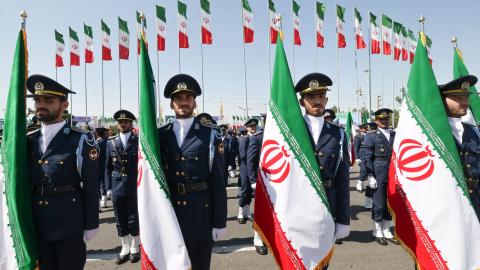From its origins, the Iran nuclear deal, the Joint Comprehensive Plan of Action, or JCPOA, has suffered from contradictory assessments of its expected outcomes. Deal supporters assert that it blocks all of Iran’s paths to the bomb, while opponents contend that it paves those paths.
As Iran moves ever closer to the nuclear weapons threshold — using the illegally built nuclear infrastructure decriminalized and guaranteed by the JCPOA itself — the critics appear increasingly prescient.
Among the many competing claims about the JCPOA were those that placed it in the broader context of international arms control. Former European Union High Representative for Foreign Affairs and Security Policy Federica Mogherini often referred to the deal as “an essential component of the global non-proliferation architecture.”
This stood in stark contrast to Israeli Prime Minister Benjamin Netanyahu’s warnings that the JCPOA would spark a regional nuclear arms race. His argument was that Iran’s neighbors would insist on securing for themselves the same weapons-relevant nuclear capabilities that the deal gave Tehran. In Netanyahu’s controversial 2015 speech before Congress, he predicted, “This deal won’t be a farewell to arms. It would be a farewell to arms control.”
The recent publication of Saudi Arabia’s demands for assistance with uranium enrichment and other elements of the nuclear fuel cycle is the latest evidence that the Middle East nuclear arms race the Israeli prime minister predicted eight years ago has begun. If the United States fails to act now, future regional conflicts in a nuclear Middle East will threaten the safety and security of the entire world.
Riyadh’s insistence on enrichment follows previous revelations of Saudi activity since the conclusion of the JCPOA that appears aimed toward matching Iran’s growing ability to produce and deliver nuclear weapons. In August 2020, the Wall Street Journal reported that, with the help of China, the Saudis have built a facility to process uranium ore. In December of the following year, the Journal revealed that the kingdom, again with Chinese assistance, is producing its own ballistic missiles.
The U.S. is incentivizing regional nuclearization by downplaying the Iranian nuclear threat, excessively restraining its responses to Iranian nuclear violations and other provocations and alienating and undermining its allies in the Middle East. The Saudis have stood out as the target of scorn from President Biden and his administration from even before the 2020 election.
The way to halt and even reverse the Middle East nuclear arms race is straightforward and requires two steps under U.S. leadership.
First, it is well past time to end, rather than enable, Iran’s nuclear weapons program. The U.S. should work with its European allies to activate the JCPOA’s snap-back mechanism, which would reimpose the United Nations arms embargo on Iran and a complete ban on Iranian uranium enrichment. It also would block the lifting of the U.N. missile embargo scheduled for October, which undoubtedly would be welcome news in Kyiv and other European capitals threatened by Iranian missiles in Russian hands.
The United States should lead the imposition of a well-coordinated mix of economic, diplomatic and military pressure on the Islamic Republic until the latter complies with its international nuclear obligations. The administration, Congress and the military should make it clear that the United States is not just willing and able but unequivocally committed to using force to end Iran’s nuclear weapons program if Tehran refuses to do so. Ostensibly because of the administration’s commitment to diplomacy, it has been reticent to pose such a threat. Yet without a credible American military threat, a genuine diplomatic solution to the Iranian nuclear problem never will be possible.
Second, the United States should take a complementary approach to its allies and partners in the Middle East, by providing them with the diplomatic and military support necessary both to deter Iran and to instill in them sufficient confidence to obviate their own pursuit of nuclear weapons.
The U.S. and Saudi Arabia have obvious differences. President Biden faces a choice about how to resolve them. He could continue to placate Iran and ostracize the Saudis, driving the latter and others to pursue nuclear weapons and into the waiting arms of China.
Alternatively, the president could engage and reassure the Saudis, as well as the Israelis and their neighbors, by taking an unambiguously tough stance against Iran’s nuclear offenses and regional aggression, while demonstrating a renewed American commitment to Middle East security and stability and to addressing disputes collaboratively with U.S. allies and partners. This approach requires resolve and a willingness to break from an Obama legacy issue, but it is the only way to check the nuclear arms race that the JCPOA ignited.



















